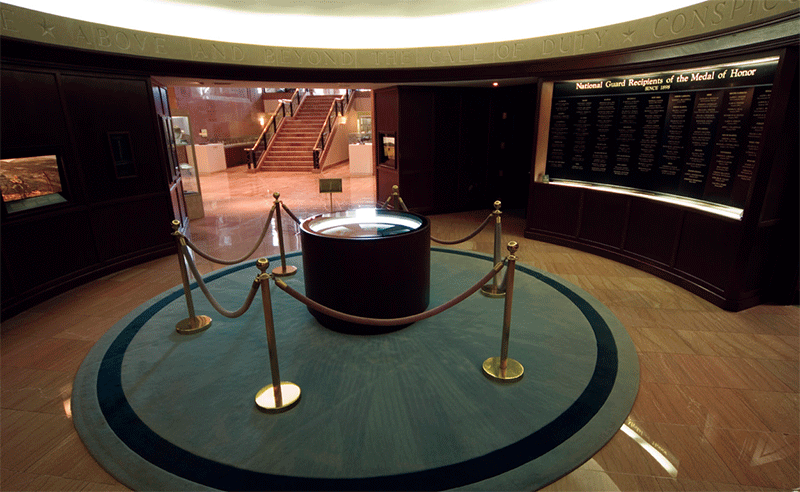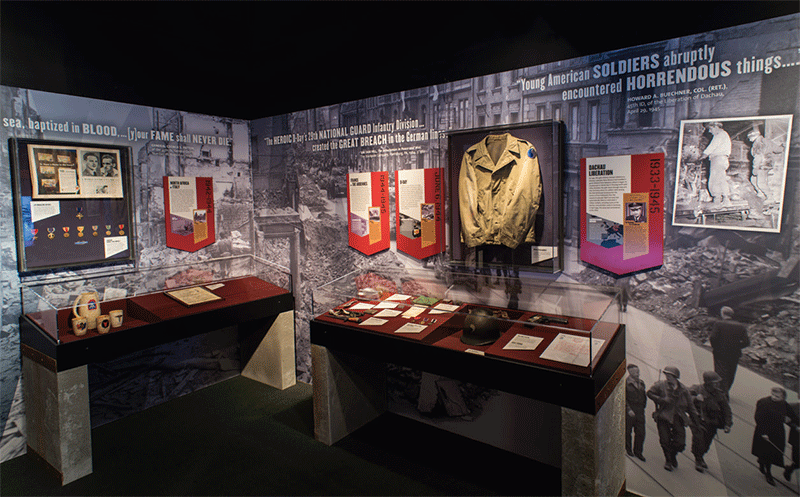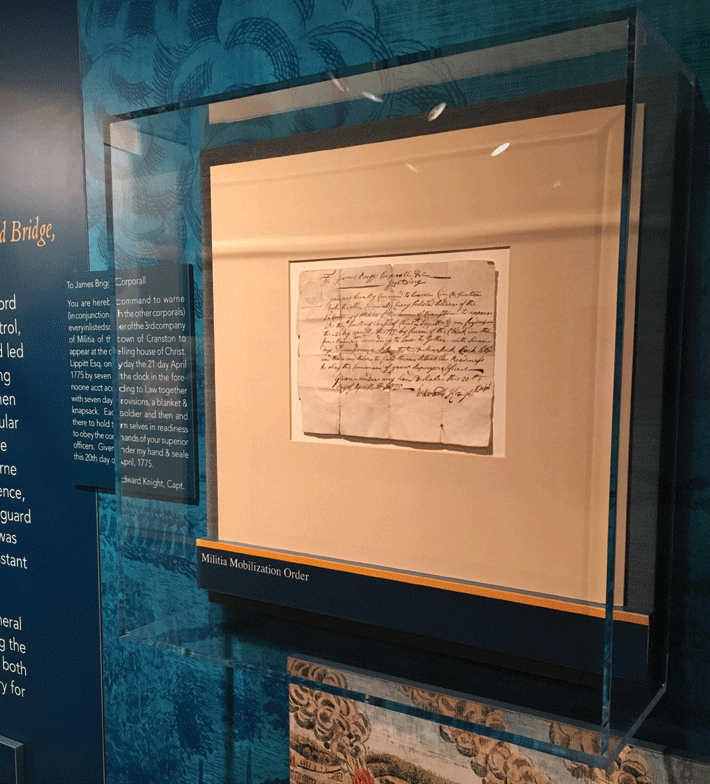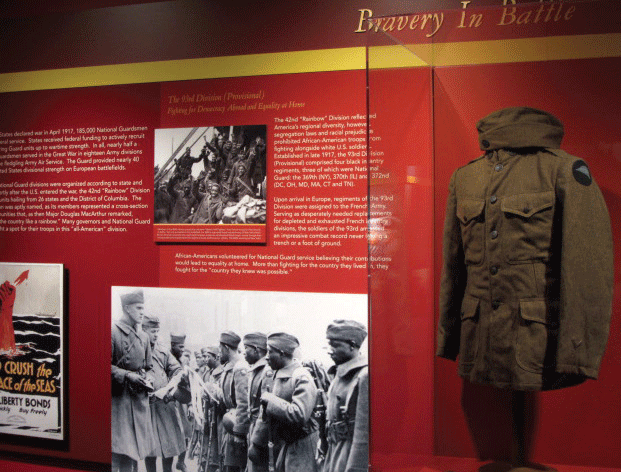The National Guard Memorial Museum
The National Guard Memorial Museum
By Anne Armstrong, Deputy Director, National Guard Educational Foundation

In 1975, Colonel James Deerin dreamt of starting a National
Guard Heritage Gallery in the heart of Washington, DC. While
working for the National Guard Association of the United States
(NGAUS), Deerin saw a need for a gallery to match the thriving
library and growing archive housed at NGAUS headquarters. Most
importantly, he wanted to celebrate the upcoming Bicentennial with
a museum that covered the entire history of the National Guard.
He began a year-long search for artifacts to put together a gallery
worthy of the Bicentennial. By 4 July 1976, Deerin had created
what would become the National Guard Memorial Museum, with the
mission of telling the story of the National Guard from its inception
in December 1636 to the present.
In 1990, the NGAUS building was razed and rebuilt. In 2003,
the Heritage Gallery finally found its permanent home in the lower
level of the NGAUS building and was renamed The National Guard
Memorial Museum. With 5,600 square feet of exhibit areas, additional
space in the building’s lobby, and two artifact rooms, the
National Guard Memorial Museum details the history of the National
Guard with a view of the entire force. The museum is comprised
of six galleries that describe the evolution of the Guard from precolonial
militias to a globally deployed force.
The first item to catch the visitor’s attention is a carefully
detailed diorama of the 1636 First Muster, made famous by Don
Troiani’s National Guard Heritage Series painting. Important artifacts
follow along in the chronology as visitors move through the
museum, starting with the April 1775 Militia Order. This small
document, folded into even tinier squares, orders a single man to
meet on the public grounds for a muster which, as fate would have
it, helped launch the American Revolution.
Stepping into the Revolutionary and Civil War Gallery,
visitors see the original artifacts collected so carefully by Colonel
Deerin. Many examples of common utensils, tools, and musical
instruments are displayed here. Uniforms and weapons are
plentiful, as well as a first pattern Confederate battle flag captured
by Illinois troops at the Battle of Pea Ridge, Arkansas, in 1862.
The end of the Civil War and the post-Reconstruction era
marked a dramatic turning point in the history of the nascent
National Guard as it was often called up to restore order brought
about by labor strife. More significant was the use of the
National Guard overseas, and the museum features artifacts of
National Guardsmen in the Spanish-American War and Philippine
Insurrection. In 1903, Senator Charles W. F. Dick (R-OH) penned
the act named for him that enumerated drill days, pay rates, uniform
and equipment requirements, and a general drive to parallel the
Regular Army in every capacity possible. Visitors may view
original handwritten notes of Senator Dick as well as his battle
sword and his dress hat, worn at the inauguration of President
William McKinley, in a temporary gallery in the museum’s lobby.
Back in the museum, visitors encounter the first of many
displays on the role of African Americans in the National Guard.
African American Guard troops played a significant role in
World War I. Among the artifacts reflecting this is the uniform
of Sergeant Henry Johnson, a recipient of the Medal of Honor
and a member of the New York National Guard’s 369th Infantry
Regiment (Harlem Hellfighters). Other World War I artifacts on
display include a collection belonging to Sergeant Tommy Reno of
the 28th Division (Pennsylvania National Guard).





Visitors step through an archway leading from displays on
World War I to those on World War II and enter the museum’s
newest gallery featuring artifacts of the era as well as the newest
innovations in interactive exhibits. The gallery includes the
Brownie camera used to photograph the effects of the atomic
bombing of Hiroshima, original artwork by Bill Mauldin of the
45th Infantry Division, and the pistol fired by Lieutenant Colonel
Felix Sparks during the chaotic liberation of Dachau in April 1945.
Visitors can operate a map table designed to give them maximum
orientation in time and geography. Slides also display infantry
division movements in both the Pacific and European Theaters.
The next galleries address the National Guard’s role in Korea
and Vietnam. Artifacts of this era include Medal of Honor recipient
Lewis Millett’s M1 Garand bayonet and a uniform from Company
D, 151st Infantry, one of the few Guard units deployed to Vietnam.
Additional text and artifacts describe the Guard’s role on the home
front during the Cold War.
Next, visitors encounter the effects of the end of the Cold War
on the National Guard. This is followed by exhibits on the Guard
and the attacks of 11 September 2001 that include the uniform
of the first fighter pilot, Captain Heather Penney, to fly over the
Pentagon after it was struck, as well as a facsimile order from Vice
President Dick Cheney authorizing the destruction of any aircraft
entering U.S. airspace not obeying the commands of air traffic
control. Additional exhibits cover subsequent military operations
in Afghanistan and Iraq and include a Special Forces uniform, the
uniform jacket and lowering cable from a Guardsman who took
part in Operation BULLDOG BITE, and the uniform blouse of
Sergeant Leann Hester (Kentucky Army National Guard), Silver
Star recipient and the first woman recognized for valor in combat.
Lastly, and most importantly, visitors may reflect on the
gravity of war by viewing the Wall of the Fallen, a mahogany and
steel wall dedicated to National Guard personnel lost in the Global
War on Terrorism. The wall identifies every fallen Guardsman by
name, state, rank, and age at time of death. Facing the wall is an
exhibit dedicated to the National Guard’s first four-star general,
General Craig McKinley, that includes the pen used by President
Barack Obama to authorize the promotion. The challenge coins of
the members of Congress who helped make the promotion happen
are also on display.
Co-located with the museum is a Medal of Honor Gallery, as
well as a 7,000-volume research library. The museum also has a
small gift shop.
The history of the National Guard may be viewed in The
National Guard Memorial Museum, which tells the Guard story
through text, artifacts, and interactive displays. The museum takes
the visitor on a tour through over 350 years of Guard history. The
National Guard Association of the United States is the proud owner
of an impressive collection of historical artifacts and welcomes all
visitors to its museum.
Making a Visit:
The National Guard Memorial Museum is located at
One Massachusetts Avenue, NW, Washington, DC. It
is open Monday through Friday, 0900 to 1600, and
closed federal holidays. Admission is free; donations are
welcome. Paid parking is available under the building
with an entrance located southbound on North Capitol
Street. The museum is accessible via Metro on the Red
Line at nearby Union Station as well as by Metrobus.
The museum is designed to be self-guided but tours are
available anytime during working hours. For more
information and a virtual tour, visit www.ngef.org.
Story Courtesy of The Army Historical Foundation.


